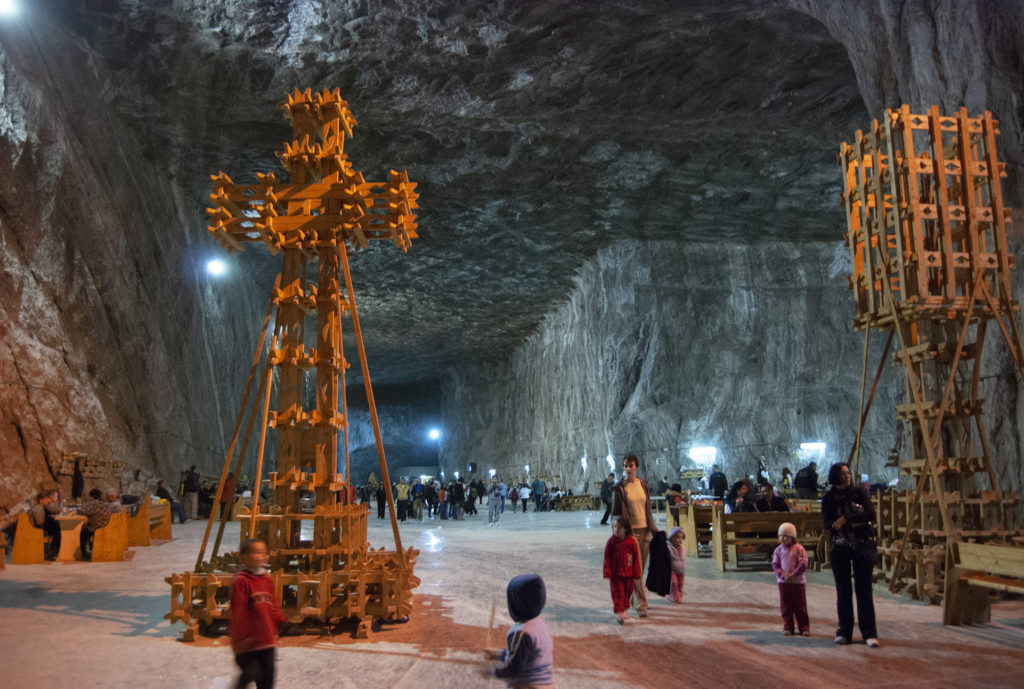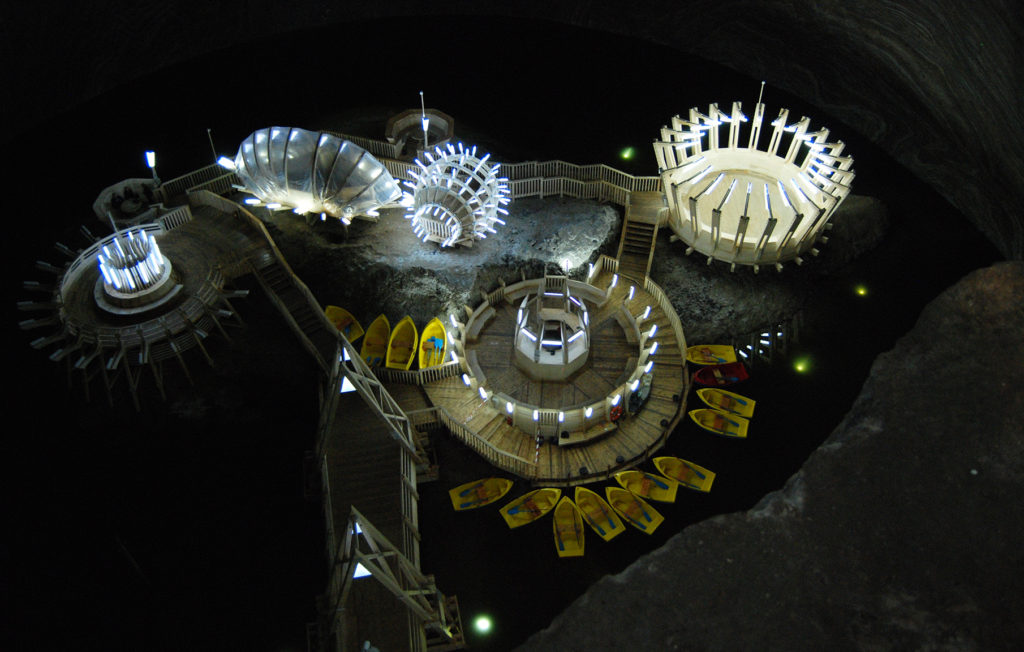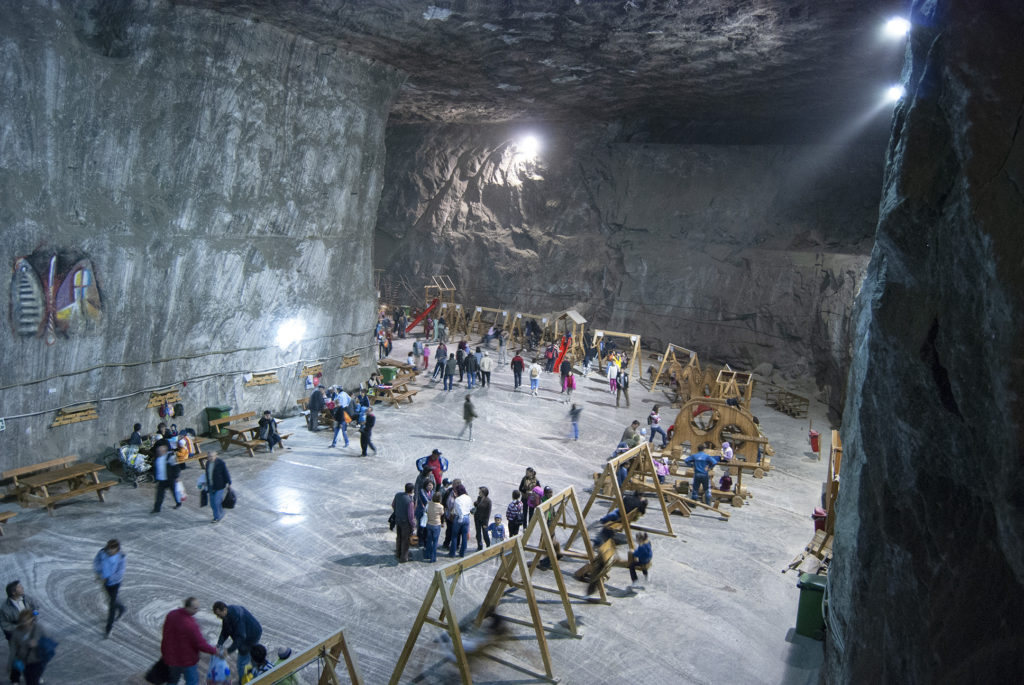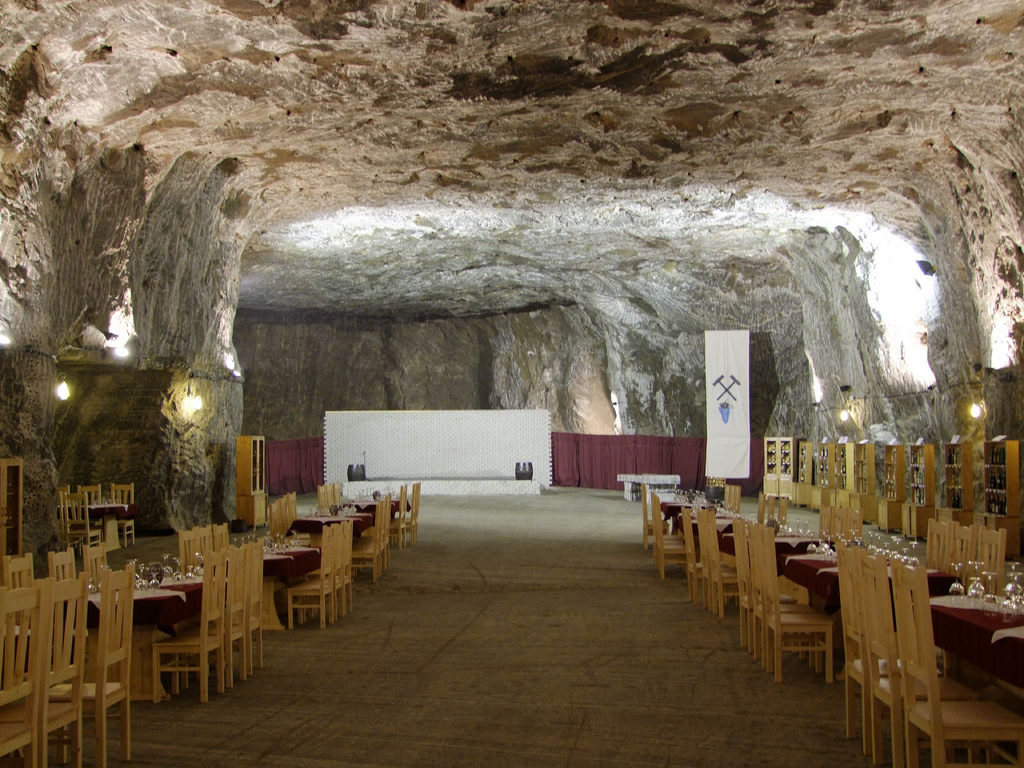Underground Romania: Salt Mines
Written by Melline Galani.
Wars were fought over it, borders of empires were pushed toward it, world maps were drawn according to it, and the Romans also came for it… salt.
The largest deposit that Romania has is salt. For Greeks, Jews, Arabs, and Romanians, salt is also a symbol of hospitality and friendship, with the added value of a brotherly bond. In Romania, for instance, guests are often greeted with salt and bread. Salt is also considered a primary element because the amniotic fluid in which embryos are immersed is salty, like the sea from which life on the planet appeared.
Romania used to have dozens of large salt mines, as well as many other places where deposits were taken from the surface. However, many of these collapsed, forming salt lakes on the surface near which treatment bases have been developed. Presently, only seven are being used for extracting salt, while ten have been transformed into underground amusement parks.
Nowadays, many tourists from home and abroad visit Romania’s salt mines, not only for the amusement they provide, but also for therapy. The constant air temperature in a salt mine is rather low and ranges from 10–16 degrees Celsius. The relative humidity has minimal variation with values of 78–82 percent at the entrance of the mine and average values of 73–80 percent in different rooms. The concentration of allergens is zero, and there are no pathogens or germs, resulting in extremely fresh air.

Salt therapy (halotherapy) is an alternative treatment practiced dating back to ancient times, which even today ensures the best results. Inhalation of saline aerosols has curative properties, a natural adjuvant for various chronic health issues such as asthma, bronchitis, coughing, respiratory infection, respiratory failure, pulmonary emphysema, pharyngeal polyps, rhinitis, chronic tonsillitis, and sinusitis.
A visit to a salt mine can be helpful not only for people with low immunity and neurological problems such as paralysis or muscular dystrophy but also for people who are prone to allergies. Saline treatments can also aid those with allergic dermatitis, osteoarthritis, spondylosis, or other chronic joint diseases. For efficient treatment of respiratory problems, one should spend two to four hours daily, for at least ten days, in a salt mine. When my daughter was four years old, she had a weak immune system due to repeated colds, so we went to Praid Salt Mine for two weeks and did the inhalation of saline aerosols treatment. Her condition and immune system improved considerably afterward, so the therapy really worked for us.
Though I visited many salt mines back home, I have chosen the two that I love most to write about in more detail: Praid Salt Mine and Turda Salt Mine.
Turda Salt Mine
Turda Salt Mine is located near a town of the same name in the northeast of Romania and is one of the oldest salt mines in the world. It was dug during medieval times for salt exploitation, with the first documented reference of the mine dating all the way back to 1271. From the 13th century until 1932, the mine was active. Between 1932 and 1992 it was closed, and when it was reopened, it was for tourists and people with medical problems, as the air in the salt mine is recognized as being the best remedy for those with respiratory problems. In 2010, it was reopened after extensive modernization that cost around 5,800,000 euros (approximately 6,500,000 US dollars). It took two years to complete, becoming the most ecological salt mine in Romania, with no pollution source around it and a unique shape aboveground.

At 120 meters below the surface, there are several parts to the mine, arranged with different purposes in mind: There is an 80-seat amphitheater for concerts and musical auditions, a golf course, an underground lake with paddle boats for hire, a treatment base and a medical office, a church, a sports area (for bowling, soccer, table tennis), and a Ferris wheel. Considering all the available attractions, it is easy to see why Business Insider placed the mine on top of their list of “coolest underground places in the world.”1
Today, Turda Salt Mine is a genuine history museum for salt exploitation. The excellent condition of the mining compartments and equipment used for salt transportation, as well as the care with which the mine was prepared for touristic use, have turned it into a place fusing both history and legend. The high number of tourists going there from many parts of the world is but a confirmation of its historical and touristic value.

The visiting hours are from Monday to Sunday between 9 a.m. and 5 p.m. (last entrance is at 4 p.m.). The entry fee is 9 US dollars per day per person, but pensioners, children, and students benefit from discounts (there are also weekly packages available at discounted prices). For more information, visit: https://salinaturda.eu/ (English version available).
Praid Salt Mine
Praid Salt Mine (Parajdi Sóbánya in Hungarian) is located in the eastern Transylvanian county of Harghita (home to one of the biggest Hungarian minority populations in Romania), in a village of the same name (Praid). Praid Salt Mine is popular both among people seeking treatment for various respiratory ailments and among tourists looking to relax and spend some quality time with friends and family for a few hours.
Large-scale extraction of salt began at Praid in 1762 when Transylvania formed part of the Habsburg Empire. It was supervised by the imperial mining officer Johann Frendl, and in 1787, the mines became the property of the Habsburg government in Vienna. Extraction continued during the nineteenth century, but new technology employed from the late 1940s enabled production to be increased substantially. From the 1960s, following the example of the mine Wieliczka, Poland, the therapeutic qualities of the atmosphere in the mine were recognized. Therefore, facilities were provided for people with respiratory conditions to spend several hours a day underground, during which they could take part in varied activities and, if necessary, receive treatment.

Access to the mine is available by bus through a 1,500-meter-long tunnel and then descending 300 steep steps, making it a real underground city at about 120 meters below the surface. The mine offers a wide variety of convenient and fun services and facilities, such as Wi-Fi, playgrounds for children, a church, a 3D cinema, a coffee shop, and a restaurant, among other things. The average annual temperature in the underground area is 16 degrees Celsius, so dress warm. There is also an underground adventure park where children and adults alike can walk down trails of various difficulty. Also, in the mine, there is an inflatable playground for children as well as workshops tailored for them where they can work on their creativity. There is also an underground wine cellar where tourists can taste and buy different types of wine and Romanian liquors.

In the mine, you can also visit a museum on the history of salt mining in Romania. A variety of documents, tools, and work items dating from the 18th century are on display. The documents mention that the mine dates back to the Roman Empire, especially since bricks with the inscription “Legio Quinta Macedonica” (the Fifth Macedonian Legion2) have been found.
Nowadays, salt is being mined 400 meters deeper than the treatment area. Also, on the exit route, there is a panorama from where visitors can see how salt mining used to be carried out. Praid Salt Mine also welcomes guests to the largest outdoor saltwater pool in Romania. It was opened in the summer of 2014 and covers 5,200 square meters, out of which around 2,000 make up the pool. The salinity of the swimming pool is high, around 220 milligrams of salt per liter of water, and is recommended for the treatment of rheumatic disorders. The best part of the saltwater pools is that you do not need to know how to swim, because you will float no matter what. But pay attention not to get water into your eyes because it stings badly. For more information, visit the Facebook page: Parajdi Sóbánya – Salina Praid – Salt mine Praid.
If you happen to be in Romania for traveling or any other purpose, a salt mine is a must-see for both its uniqueness and amusement. And since we have many spread all across the country, it is not difficult to choose one.
Footnotes
1 https://www.businessinsider.com/world-underground-attractions-2014-2
2 Legio Quinta Macedonica (the Fifth Macedonian Legion) was a Roman legion. In the year 101, the legion moved to Dacia (today’s Romania) to fight in Emperor Trajan’s campaign against King Decebalus. (https://en.wikipedia.org/wiki/Legio_V_Macedonica)
THE AUTHOR
Melline is a Romanian enthusiast, born and raised in the capital city of Bucharest, and is currently living in Gwangju. She like new challenges, learning interesting things, and is incurably optimistic. Instagram: @melligalanis.







